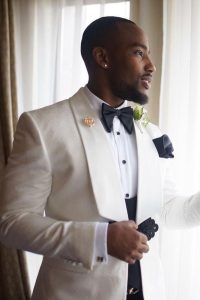The Modern Groom’s Guide to Wedding Tuxedos
There’s something about a tuxedo that immediately sets the tone. Walk into a wedding in one, and it’s clear the day is not just s regular Saturday afternoon — it’s a once-in-a-lifetime celebration. Since the late 1800s, tuxedos have been linked with refinement, exclusivity, and glamour, from high-society events in London and New York to red carpets in Hollywood. Today, that same air of sophistication makes the tuxedo a go-to for weddings across the globe, including here in South Africa.
But tuxedos are not just about tradition. Like many things on the wedding scene, they’re evolving, offering grooms and wedding parties endless ways to stand out. Whether you’re considering a midnight-blue dinner jacket, a velvet lapel, or a crisp ivory look, there’s a tuxedo to fit every type of wedding vibe.
So here’s your guide on picking the right tuxedo:
Why a Tuxedo Still Matters
Modern weddings are increasingly personal, yet formality still holds its place. If your wedding invitation says black tie or black tie optional, a tuxedo isn’t just recommended — it’s expected. More importantly, it signals respect for the occasion and the couple.
Stylists put it best: a suit can look sharp, but a tuxedo tells a different story. It’s about ceremony, luxury, and making a memory that feels distinct from every other big night out. Even if you’re not the groom, showing up in a tuxedo when the dress code calls for it helps elevate the shared atmosphere of the special occassion.
Tuxedo vs. Suit: Spotting the Difference
The line between tuxedos and suits can feel blurry, especially as fashion gets more creative. Here are the signature differences:
-
Lapel Fabric: Tuxedos feature satin, silk, or grosgrain lapels. Suits use the same material throughout.
-
Buttons and Pants: Tuxedo buttons match the lapel fabric, while trousers may include a satin stripe down the side. Suits usually come with plain buttons and standard belt loops.
-
Belts vs. Suspenders: Tuxedo trousers don’t use belts — they’re built for suspenders or side adjusters.
-
Shirts: Suits pair with standard dress shirts, but tuxedos require wingtip, pleated, or tuxedo-specific shirts.
-
Accessories: Tuxedos traditionally call for bow ties, cufflinks, and formal shoes. Suits offer more flexibility.
Understanding these details helps grooms avoid walking into a wedding looking “underdressed” in a standard suit when the occasion calls for something more elevated.
 Image Sources: Pinterest
Image Sources: Pinterest
Breaking Down the Tuxedo: Key Elements
Lapels
Lapels aren’t just decorative — they define the formality of your look.
-
Shawl Lapel: Rounded and smooth, often associated with old-Hollywood glamour. Best for grooms who want to channel James Bond energy.
-
Peak Lapel: Angled sharply upwards, creating broader shoulders and a trimmer waistline. The most traditional black-tie choice.
-
Notch Lapel: The least formal, bridging the gap between a tuxedo and a business suit. Popular for modern weddings.
Shirt Collars
Tuxedo shirts come in distinctive collar styles:
-
Wingtip Collar: The most formal, designed to show off a bow tie.
-
Spread Collar: Modern, versatile, and flattering with both bow ties and slim neckties.
-
Cutaway Collar: A bold, fashion-forward choice, often styled with suits but creeping into tuxedo looks.
Bow Tie vs. Necktie
Traditionally, bow ties reign supreme. They feel polished and ceremonial. However, more grooms today are choosing slim silk neckties for a fresh twist. The rule of thumb: if you choose a necktie, it must be in a fabric and finish that matches the tuxedo’s elegance.
Colors and Fabrics
Black remains the king of tuxedos, but modern options go far beyond:
-
Midnight Blue: Favored for evening weddings — it looks richer than black under artificial lighting.
-
Ivory or White Dinner Jackets: Popular in warm climates or summer weddings, offering a striking alternative to black.
-
Velvet Jackets: Deep jewel tones like emerald, burgundy, or navy are trending for grooms who want personality with sophistication.
Tuxedos in South African Wedding Culture
South Africa’s diverse wedding scene has given the tuxedo new life. In Johannesburg, grooms often pair classic tuxedos with subtle African-inspired touches — think patterned bow ties, pocket squares in shweshwe fabric, or velvet jackets in earthy tones that echo local landscapes.
At wine estate weddings in Stellenbosch, midnight-blue tuxedos are a favorite, blending formality with a softer romantic tone. On the coast, ivory tuxedos or white dinner jackets feel more natural against a seaside backdrop.
Local tailors are also innovating, offering custom designs that mix old-world luxury with cultural pride. Instagram posts from South African grooms show everything from traditional black-tie looks to daring printed tuxedo jackets that still feel celebratory and refined.
Tips for Grooms, Groomsmen, and Guests
-
Grooms: Make sure your tuxedo complements your partner’s attire. If their look is dramatic, you can go bolder. If it’s minimalist, stick to classic elegance.
-
Groomsmen: Match the groom’s level of formality, but avoid drawing attention away from him. Subtle differences like tie style or pocket square color are fine.
-
Guests: If the invitation says black tie, don’t improvise with a dark suit. Respect the dress code — it’s part of celebrating the couple’s vision.
Tux vs Wedding Suits: The Choice is Up to You
A tuxedo is more than fabric and tailoring. It’s a visual way of saying, this is a day worth remembering. Whether you go traditional in black satin or break the rules with velvet and bold colors, the right tuxedo transforms the occasion and leaves a lasting impression.
For grooms, it’s not just about looking sharp — it’s about matching the moment. And in the world of weddings, that’s what style is truly about.

